Цели:
Образовательные:
- совершенствовать умения и навыки практического владения английским языком;
- активизировать словарный запас учащихся по теме.
Воспитательные:
- обобщить страноведческие знания учащихся;
- повысить интерес учащихся к изучению иностранного языка.
Оснащение:
- ТСО – интерактивная доска;
- видеофильм;
- наглядные материалы;
- картинки.
Ход мероприятия
(на протяжении мероприятия учащиеся смотрят видеофильм)
Teacher: Dear students, I liked the idea of inviting British students of a Local State School in London to visit our school. Let me introduce our guests. They have come to our school as part of their visit to Russia. They will stay with your families. And today we are going to speak about traditional Russian clothing
Student 1: Traditional Russian clothing
Russian dress and traditional symbols are a part of Russian culturе. We know our predecessors by their tales, songs and legends, as well as by a great variety of original clothes and household things created mainly by some unknown talents. When looking at ancient holiday garments of peasantry one cannot help wondering at their unusual harmony and power of life emanating from these things and their ability to hand down the visible image of our ancestors and convey their spiritual essence to us.
Student 2: Historians suppose that traditional Russian costume started taking its shape in the 12th-13th centuries. Up to the 18th century it fitted well all layers of Russian society: it was worn by tsars, boyars, merchants, craftsmen, and peasants. Traditional Russian clothing was designed to empathize Russian woman's inner dignity and emotional restraint. Russian costumes are not only beautiful, there are also convenient in wearing because they were created for work without restricting freedom of movement. Festive clothes and everyday clothes, married woman's and young girl's clothes differed only for details, decoration, color gamut. The variety of colours for traditional costume displays love for beauty and ethnic diversity. Red fabric cloth was considered to be the nattiest one, and, by the way, the Russian word "beautiful" comes from the word "krasny", the Russian for "red".
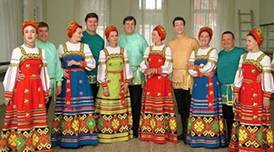
Student 3: The Russian women’s costume was based on the “rubakha” (a linen shirt or blouse). It was made flaxen embroidery, silk lace, golden threads and spangles. Collars and sleeves were decorated extensively.
By the early 20th century the most widespread women costumes were of two types: the South Russian one with poneva, i.e. a homespun woollen skirt, and the Mid-Russian one with a sarafan, i.e. a kind of sleeveless dress. The typical colour of the sarafan and skirts was red, as this colour literally translates to “beautiful”.
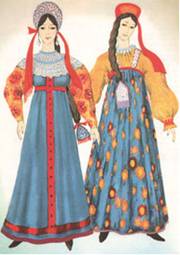
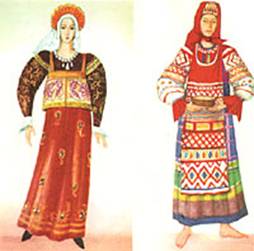
Student 4: Wedding garments in Old Rus’ used to be very colourful, the red being the major wedding colour. White was considered the colour of sanctity and was not used in festivities. In many regions the bride had two wedding gowns: one to wear before the marriage service and the other to put on after it. The first one was very simple, modest and even mournful: in some places the bride was even wearing black, including a black wedding veil. The second one was always of red colour symbolizing joy.
A wedding dress consisted of a sarafan (pinafore dress) and a blouse put on underneath. However, the same was with everyday garments. What made the wedding dress peculiar was its trimming first of all. The underblouse was decorated with rich embroidery of ornaments depicting leaves, berries, roosters and other birds. Birds being the symbol of the good were a favourite motive of embroidery.
The wedding headwear of Russian brides descended from flower wreaths (the oldest decoration) and in the 11-14th century it was a ribbon or a metal headband encircling the forehead and fastened at the back of the head. The hair was left loose or did up in two plaits. Later kokoshnik came to use as a wedding headdress.
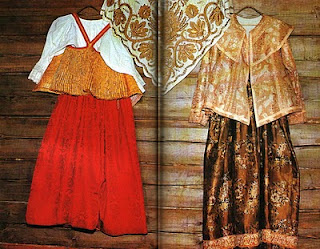
Student 5: One of the most common type of festive head-dress was the "kokoshnik", it was masterfully decorated with river pearls, meshwork of pearls, golden and silver needlework, coloured foil and decorative stones. The head-dress was treasured in the family and handed down, and was an integral element of a well-off bride’s dowry.
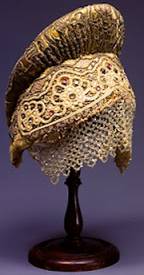
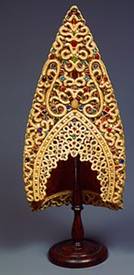
Student 6: Mens'clothing was simpler and more uniform over women's.Men’s costume was composed of a long shirt (rubakha-kosovorotkas – a shirt with a stand-up collar fastening on the side), trousers (porty), a belt (poyas- kushak).. The cap (kartuz) came into being in the late 19th century, an it was decorated with a flower.
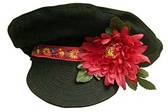
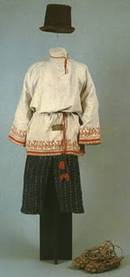
Student 7: The great variety of winter clothing traditionally worn in Russia strikes the imagination: fur coats shuba) (sheepskin coats, overcoats, fur-lined dresses—fashions and cuts have changed over the years, but warm winter attire has always been an important part of traditional Russian clothing. Shubas were made of fur turned inside or ‘wrong-side out’.
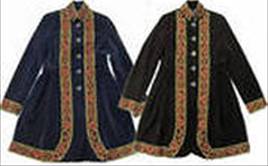
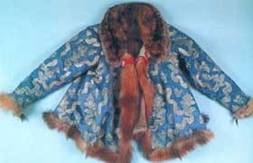
Student 8: What is traditional Russian clothing without Russian valenki? They were worn both by rural people and also the tsar’s family. The centuries-long tradition of producing these warm seamless felt boots by traditional technology has won them great acclaim, both in Russia and abroad. It was extremely practical and effective in a cold northern climate.
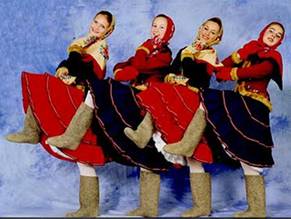
In Russian self-perception the braided footwear known as lapti is one of the most important symbols of the traditional national mode of living.The lapti made of bast or birch bark were the main type of peasant footwear in Russia till the mid 19th century.The lapti were worn with the onucha, i.e. a puttee, a strip of cloth wrapped round the foot. The onucha was fastened to the leg with a may accompany valenki to protect them from getting wet.
Student 9: Russian peasants used to wear lapti (bast shoes), whereas in towns high boots were the most common footwear. Heeled boots appeared in Russia somewhat in the 14th century. The high boots were usually square-tipped, whereas the nobles were distinguished by upturned toes. The tops of the boots were comparatively short and angularly cut towards the knees. They were sewn of coloured leather, morocco, brocade or velvet and were often decorated with embroidery and even gems. In the late 17th century under the influence of western fashions the nobility started to wear low shoes.
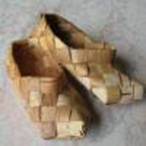

Student 10: The traditional male warm hat with flaps – ushanka (derived from the word ushi – ears) or treukh – was used to protect the ears from cold.
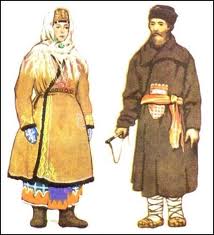
Russian womеn worn the traditional Russian shawls.
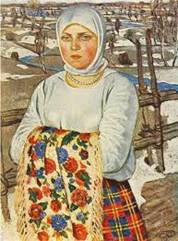
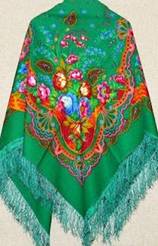
Dresses of the noblemen and noblewomen were made of expensive fabrics, with use of gold, silver, pearls and expensive buttons. Such garments often descended. The cut of costumes remained unchangeable for centuries. There was no such notion as fashion.
Student 11: After Peter’s decrees (18th century) Russian nobility and the city costumes have undergone Europeanization. However, the national (folk) Russian costume was popular in the villages till the beginning of 20th century.
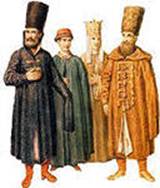
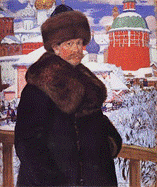
Teacher: Now you know a lot about traditional Russian clothing . Mr. Stephen Wooding, the Head Teacher of Local State School in London would like to invite a group of up 12 students and 2 teachers from our school to visit them. Do you like the idea? Soon we’ll get the invitation letter.